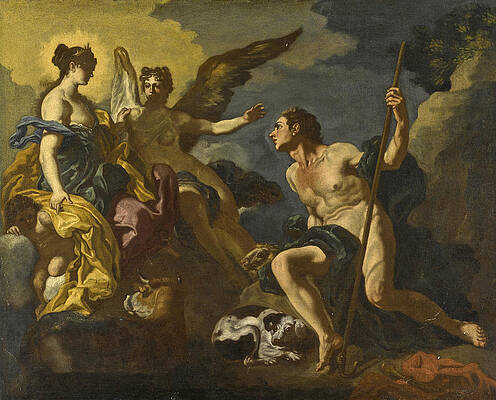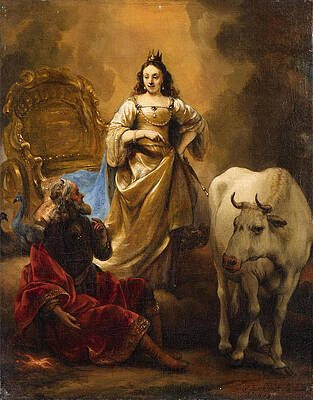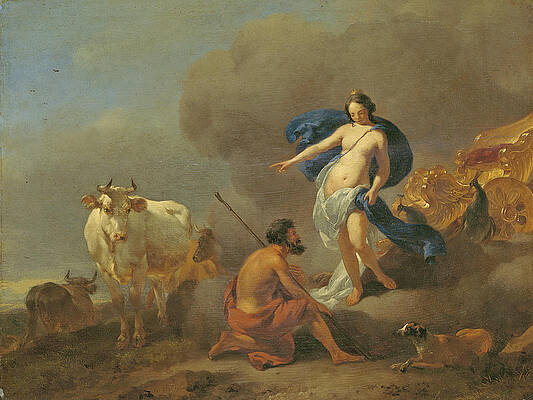.
Jupiter and Io. Correggio
In Greek mythology, Io was the daughter of Inachus, a river god (it should be noted that the early genealogy of the House of Argos is very confusing; depending on the source, Io had different parents).
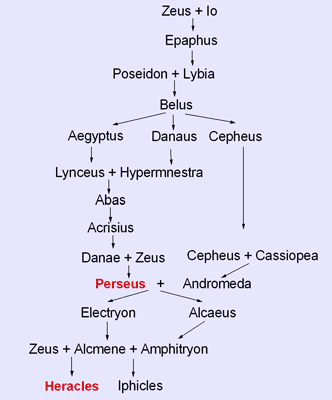
Simplified Heracles and Perseus Genealogy
One day, Zeus noticed the maiden, and took her as one of his many lovers. Their relationship continued until Zeus's long-suffering wife, Hera, almost caught them together. Zeus turned himself into a white cloud - and Io into a beautiful white heifer - to try to avoid detection, but Hera was not fooled. She demanded the heifer as a present.

Argus "Panoptes" guarding the cow Io

Hermes, Argus Panoptes and Io
Hera placed Io in the charge of Argus (the many-eyed monster) to keep her separated from Zeus. Zeus commanded Hermes to kill Argus, which he did by lulling all 100 eyes to sleep. Hera then forced Io to wander the earth without rest, plagued by a gadfly to sting her into madness. Io eventually crossed the path between Propontis and Black Sea, which thus took the name Bosporus (meaning ox passage), where she met Prometheus.
Prometheus had been chained on Mt. Caucasus by Zeus for teaching Man how to make fire and tricking him into accepting the worse part of a sacrifice while the mortals kept the best part (meat); every day, a giant eagle fed on Prometheus's liver. Despite his agony, he tried to comfort Io. He told her that she would be restored to human form and become the ancestress of the greatest of all heroes, Heracles. Io escaped across the Ionian Sea to Egypt, where she was restored to human form by Zeus. There, she gave birth Zeus's son, Epaphus. She later married Egyptian king Telegonus.
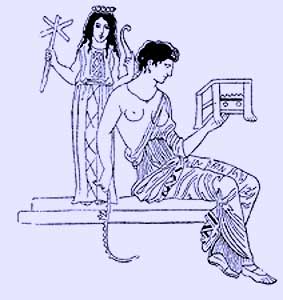
Io, behind a xoanon of Artemis.
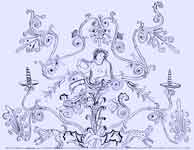
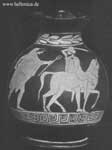
Hermes, Argus Panoptes and Io, Boston Museum
Hermes, Io and Argus. black-figure amphora, 540/30 BC
Juno accompanied by Iris gives Argus Charge of Io transformed into a Cow, Studio of Francesco Solimena
Juno Jupiter and Io, Gerbrand van den Eeckhout
Mercury Argus and Io, Govert Flinck
Juno confiding Io to Argus, Francesco de Mura
Juno commanding Argus to keep watch on Io, Nicolaes Pietersz Berchem
Juno discovering Jupiter with Io, Pieter Lastman

The term Io fly is derived from the gadfly Hera sent to torment Io into fleeing to Egypt after Argus was slain.
Io is the subject of one of Antonio Correggio's most famous paintings.
Images
The goddess Isis receives Io (with cow's horns)in Egypt.
Hermes, Io and Argus, The Pisticci Painter, 450–/40 BC Red Figure Oinochoe, Museum of Fine Arts, Boston
See also : Greek Mythology. Paintings, Drawings
| Ancient Greece
Science, Technology , Medicine , Warfare, , Biographies , Life , Cities/Places/Maps , Arts , Literature , Philosophy ,Olympics, Mythology , History , Images Medieval Greece / Byzantine Empire Science, Technology, Arts, , Warfare , Literature, Biographies, Icons, History Modern Greece Cities, Islands, Regions, Fauna/Flora ,Biographies , History , Warfare, Science/Technology, Literature, Music , Arts , Film/Actors , Sport , Fashion --- |
Retrieved from "http://en.wikipedia.org"
All text is available under the terms of the GNU Free Documentation License


